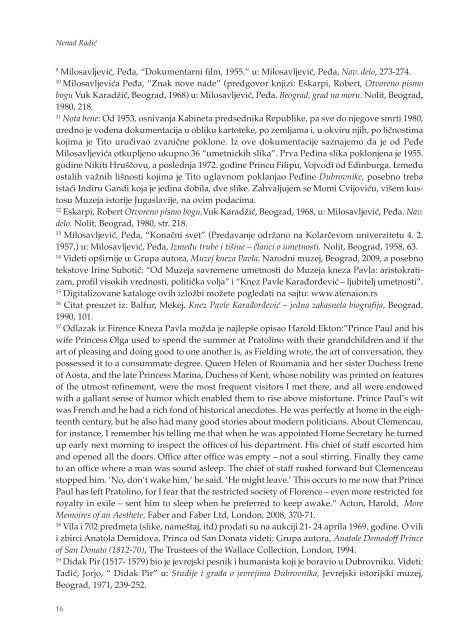Zbornik seminara za studije moderne umetnosti br. 9 (pdf) - Atenaion
Zbornik seminara za studije moderne umetnosti br. 9 (pdf) - Atenaion
Zbornik seminara za studije moderne umetnosti br. 9 (pdf) - Atenaion
Create successful ePaper yourself
Turn your PDF publications into a flip-book with our unique Google optimized e-Paper software.
Nenad Radić<<strong>br</strong> />
9 Milosavljević, Peđa, “Dokumentarni film, 1955.” u: Milosavljević, Peđa, Nav. delo, 273-274.<<strong>br</strong> />
10 Milosavljevića Peđa, “Znak nove nade” (predgovor knjizi: Eskarpi, Robert, Otvoreno pismo<<strong>br</strong> />
bogu Vuk Karadžić, Beograd, 1968) u: Milosavljević, Peđa. Beograd, grad na moru. Nolit, Beograd,<<strong>br</strong> />
1980, 218.<<strong>br</strong> />
11 Nota bene: Od 1953, osnivanja Kabineta predsednika Republike, pa sve do njegove smrti 1980,<<strong>br</strong> />
uredno je vođena dokumentacija u obliku kartoteke, po zemljama i, u okviru njih, po ličnostima<<strong>br</strong> />
kojima je Tito uručivao zvanične poklone. Iz ove dokumentacije saznajemo da je od Peđe<<strong>br</strong> />
Milosavljevića otkupljeno ukupno 36 “umetnickih slika”. Prva Peđina slika poklonjena je 1955.<<strong>br</strong> />
godine Nikiti Hruščovu, a poslednja 1972. godine Princu Filipu, Vojvodi od Edinburga. Između<<strong>br</strong> />
ostalih važnih lišnosti kojima je Tito uglavnom poklanjao Peđine Du<strong>br</strong>ovnike, posebno treba<<strong>br</strong> />
istaći Indiru Gandi koja je jedina dobila, dve slike. Zahvaljujem se Momi Cvijoviću, višem kustosu<<strong>br</strong> />
Muzeja istorije Jugaslavije, na ovim podacima.<<strong>br</strong> />
12 Eskarpi, Robert Otvoreno pismo bogu,Vuk Karadžić, Beograd, 1968, u: Milosavljević, Peđa. Nav.<<strong>br</strong> />
delo. Nolit, Beograd, 1980, str. 218.<<strong>br</strong> />
13 Milosavljević, Peđa, “Konačni svet” (Predavanje održano na Kolarčevom univerzitetu 4. 2.<<strong>br</strong> />
1957,) u: Milosavljević, Peđa, Između trube i tišine – članci o <strong>umetnosti</strong>. Nolit, Beograd, 1958, 63.<<strong>br</strong> />
14 Videti opširnije u: Grupa autora, Muzej kne<strong>za</strong> Pavla. Narodni muzej, Beograd, 2009, a posebno<<strong>br</strong> />
tekstove Irine Subotić: “Od Muzeja savremene <strong>umetnosti</strong> do Muzeja kne<strong>za</strong> Pavla: aristokrati<strong>za</strong>m,<<strong>br</strong> />
profil visokih vrednosti, politička volja” i “Knez Pavle Karađorđević – ljubitelj <strong>umetnosti</strong>”.<<strong>br</strong> />
15 Digitalizovane kataloge ovih izložbi možete pogledati na sajtu: www.atenaion.rs<<strong>br</strong> />
16 Citat preuzet iz: Balfur, Mekej. Knez Pavle Karađorđević – jedna <strong>za</strong>kasnela biografija, Beograd,<<strong>br</strong> />
1990, 101.<<strong>br</strong> />
17 Odla<strong>za</strong>k iz Firence Kne<strong>za</strong> Pavla možda je najlepše opisao Harold Ekton:”Prince Paul and his<<strong>br</strong> />
wife Princess Olga used to spend the summer at Pratolino with their grandchildren and if the<<strong>br</strong> />
art of pleasing and doing good to one another is, as Fielding wrote, the art of conversation, they<<strong>br</strong> />
possessed it to a consummate degree. Queen Helen of Roumania and her sister Duchess Irene<<strong>br</strong> />
of Aosta, and the late Princess Marina, Duchess of Kent, whose nobility was printed on features<<strong>br</strong> />
of the utmost refinement, were the most frequent visitors I met there, and all were endowed<<strong>br</strong> />
with a gallant sense of humor which enabled them to rise above misfortune. Prince Paul’s wit<<strong>br</strong> />
was French and he had a rich fond of historical anecdotes. He was perfectly at home in the eighteenth<<strong>br</strong> />
century, but he also had many good stories about modern politicians. About Clemencau,<<strong>br</strong> />
for instance, I remember his telling me that when he was appointed Home Secretary he turned<<strong>br</strong> />
up early next morning to inspect the offices of his department. His chief of staff escorted him<<strong>br</strong> />
and opened all the doors. Office after office was empty – not a soul stirring. Finally they came<<strong>br</strong> />
to an office where a man was sound asleep. The chief of staff rushed forward but Clemenceau<<strong>br</strong> />
stopped him. ‘No, don’t wake him,’ he said. ‘He might leave.’ This occurs to me now that Prince<<strong>br</strong> />
Paul has left Pratolino, for I fear that the restricted society of Florence – even more restricted for<<strong>br</strong> />
royalty in exile – sent him to sleep when he preferred to keep awake.” Acton, Harold, More<<strong>br</strong> />
Memoires of an Aesthete, Faber and Faber Ltd, London, 2008, 370-71.<<strong>br</strong> />
18 Vila i 702 predmeta (slike, nameštaj, itd) prodati su na aukciji 21- 24 aprila 1969. godine. O vili<<strong>br</strong> />
i zbirci Anatola Demidova, Princa od San Donata videti: Grupa autora, Anatole Demodoff Prince<<strong>br</strong> />
of San Donato (1812-70), The Trustees of the Wallace Collection, London, 1994.<<strong>br</strong> />
19 Didak Pir (1517- 1579) bio je jevrejski pesnik i humanista koji je boravio u Du<strong>br</strong>ovniku. Videti:<<strong>br</strong> />
Tadić, Jorjo, “ Didak Pir” u: Studije i građa o jevrejima Du<strong>br</strong>ovnika, Jevrejski istorijski muzej,<<strong>br</strong> />
Beograd, 1971, 239-252.<<strong>br</strong> />
16


